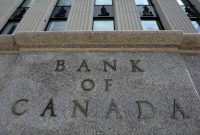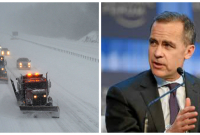Support strong Canadian climate journalism for 2025
At long last, central bankers from the G20 — a club for the wealthiest countries in the world — are waking up to the economic risks and opportunities of climate action.
Pushed to act by the Financial Stability Board, a G20 body that monitors internationally significant economic risks, central bankers in members states are beginning to address the impact of the Paris Agreement climate change targets on their respective national economies. And rightly so — it should come as no surprise that the wealthy G20 states account for roughly 85 per cent of global green house emissions.
They pose a major threat to the 1.5-degree warming limit set for this century by the agreement. Yet despite such an ambitious target looming on the horizon, there has been only silence from the Bank of Canada and the federal market regulator, the Office of the Superintendent of Financial Institutions.
Where are Canadian bankers on climate change?
In contrast to silent Canadian financial regulators, the Dutch Central Bank recently announced that it considers the low carbon energy transition to be one of the economy’s key challenges and opportunities, and that action must start now to avoid an economically disruptive transition to net zero emissions. In April, the Dutch Parliament even voted to restrict sales of new petrol and diesel cars starting in 2025 in order to meet emissions reductions goals in the transport sector. Later this year the Dutch central bank will publish a survey on how the country's pension funds, amongst the largest in Europe, report on their exposure to climate risk.
It is time for the Bank of Canada and our national financial regulators to take similar action.
The Dutch bank’s announcement follows a report by the European Systemic Risk Board (ESRB) recommending European market regulators introduce climate change scenario planning in regular stress tests for banks and insurers. These stress tests would include modelling against a sudden increase in consumer fuel prices due to higher carbon taxes, and drops in the market value of fossil fuel companies as renewable energy takes market share in the power and transport sectors.

The Dutch Central Bank and ESRB reports on climate change and the low carbon energy transition add further weight to concerns raised by Mark Carney, the former Governor or the Bank of Canada. According to Carney, now Governor of the Bank of England and Chair of the G20 Financial Stability Board, “a wholesale reassessment of prospects, especially if it were to occur suddenly, could potentially destabilize markets, spark a pro-cyclical crystallization of losses (in the fossil fuel sector) and a persistent tightening of financial conditions.”
A translation of this central banker code is that if investors and lenders in the fossil fuel sector do not proactively manage the wind down of the industry, they could find themselves left with stranded assets and bad loans. As the world acts to implement that Paris Agreement and limit global emissions, the financial risks to Canada’s hydrocarbon sector increase. The collapse of the US coal industry should serve as a warning to Canadian bank analysts who happily parrot industry reassurances of strong long-term prospects. Canadian banks' lending practices are at odds with international climate policy targets and investor expectations of growth in renewable energy displacing demand for oil sands.
According to The Economist Magazine, "one of the biggest risks to the world’s financial system is the $2.5 trillion of debt owed by oil and gas firms."
Canadian investors have cause for concern
Investor scrutiny of the large U.S. banks’ bad loans to shale gas companies has yet to play out here in Canada. Our largest banks continue lending to near bankrupt pure-play oil sands operators, repeating industry reassurances of a cyclical oil price recovery that may never happen.
This should cause concern for investors and regulators. Accelerating fossil fuel company bankruptcies would have knock effects in the banks’ much larger credit card, residential mortgage, and auto loan portfolios. These risks were flagged by the International Monetary Fund in their annual review of Canada's economy. Canadian insurers appear similarly unwilling to engage in scenario planning around the investment implications of an energy transition that is being led by the market and reinforced by the Paris Agreement.
Due to weak public reporting, it is unclear how Canada’s largest banks and insurers are acting to identify and evaluate investment risks as the low carbon energy transition gathers pace. In spite of the well recognized challenge, the Bank of Canada has so far been silent on the risks to economic stability posed by the phase out of fossil fuels.
It is time for the Bank of Canada to join its international peers in addressing these forward looking risks to ensure that the Canadian economy can weather the transition to a prosperous low carbon world.





Comments